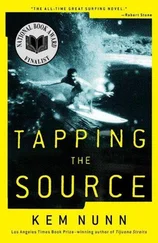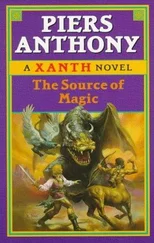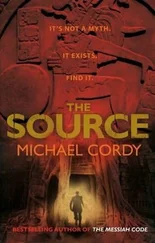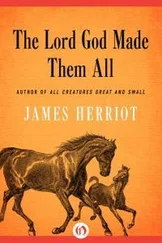Why has the mad boar triumphed, why does he growl?
Where is the path home, why is it hidden?
Why does the sun hide its face, why does it mock?
And as he felt the tragedy of these recent days he again entertained those mysterious thoughts which had begun that day when he saw his broken reflection in the well: was it the boar which had willed this dreadful day or was it a force far greater than either the boar or the lightning or the storm—some entity outside them all? Deep in the thicket he stood over the body of his son and wondered.
And the anguish that Ur knew that night—the mystery of death, the triumph of evil, the terrible loneliness of being alone, the discovery that self of itself is insufficient—is the anxiety that torments the world to this day.
LEVEL
XIV
Of Death and Life
Clay figurine of the Canaanite goddess of fertility, Astarte or Ashtart. Known to the Hebrews as Ashtoreth (plural Ashtaroth), to the Babylonians as Ishtar and to the Greeks as Aphrodite, this goddess appears repeatedly throughout the Old Testament as a permanent temptation to the Hebrews. Struck from a two-part mold in the seaport of Akka, 2204 B.C.E. Fired at 750° centigrade. Purposely buried beside the wall of Makor sometime after dark on an autumn evening in 2202 B.C.E.
High in the heavens over the desert a vulture wheeled, its glinting eye fastened to an object almost invisible in a clump of brush that grew where the drifting sand met fertile earth. Its wings fiat against the rising currents, the powerful bird drifted aimlessly in huge circles, but kept its sharp eye focused on the tiny object below, which seemed to be hesitating between death and life. The vulture showed no impatience, nor did it change its elevation. If the decision were to be death, the rapacious bird could drop quickly enough, and in the meantime its steady, waiting flight continued.
Then a change occurred. It appeared that death had come, and quickly the hovering bird ceased its drifting and inclined its wings into a steep dive. From the warm rising current which had sustained it, the vulture entered into the cold outer layers, descending in a great arching curve, its sharp eye fixed on the object that had just died. Speed and determination were necessary, for before long other birds would spot the lifeless target and would come swooping in to claim it, but on this day the solitary vulture was to be the angel of death and it sped down on silent wings.
On the ground a small donkey lay trapped with its hind leg pinched into the fork of a desert shrub, and its efforts to extricate itself had brought exhaustion. Vainly it had cried and twisted and pulled and now it could do no more. Death was very close, for from the desert came a torrid wind that intensified the little creature’s thirst, and in its last extremity the donkey ceased struggling; it was this surrender that the soaring vulture had interpreted as death, and now through dimmed eyes the little beast could see the final bird approaching. Both were prepared for death.
At that moment, pushing his way through the bushes that marked the edge of the desert, appeared a nomad wearing sandals whose thongs came upward about his ankles; across his right shoulder was fastened a cloak of yellow marked with red crescent moons. He wore a beard and carried a crooked stave which he used to knock aside the impeding brush, and from time to time he stopped to listen for a donkey that had disappeared from his caravan. He heard no sound but his eye did mark the descending flight of the vulture, and by a calculation which he had learned from his father, who had also been a nomad, he deduced from the actions of the scavenger where his donkey might be. He was afraid, from the appearance of the vulture, that the little creature was already dead, but nevertheless he hurried on, and in a moment his shepherd’s crook pushed aside the last brush—and at its base he saw his donkey very close to death, but now restored to life.
The vulture, robbed of this promised meal, uttered a croaking cry of anger, then sought an ascending current, on which it rose in great circles to a height from which it was almost invisible to the herdsman in the brush at the edge of the desert, and then remembering past good fortune, it drifted effortlessly to the west, over green lands from which it had often feasted in earlier days, until it came to the mound of Makor, in whose town another contest between death and life was about to occur, involving more important characters than a stray donkey, and more complicated forces than a hungry bird and a nomad dressed in a yellow cloak with crescent moons.
It was in the early summer of 2202 B.C.E., and in the more than seven thousand years that had elapsed from that day on which the Family of Ur had erected its monolith on the rock a sequence of changes had transformed the area. One unrecorded civilization after another had flourished briefly—successful ones had lasted a thousand years; the unsuccessful, only two or three hundred—but each had left behind an accumulation of rubble as its buildings were demolished and its inhabitants led away to slavery. Ruins had grown upon ruins until some twenty feet of debris obscured the original rock, obliterating even its memory, except that from its secure footing in the high place the ancient monolith still pushed its head through rubble to protrude a few feet into sunlight. It was the holiest object in this part of the land and was believed to have been placed in its exalted position by the gods themselves.
The rest had vanished. The roof of the cave was collapsed and the mouth, which had seen so much traffic in its numberless millennia, was filled in, so that not even goats could creep into the cool retreat that had served them for so many years. At the well, which still explained the concentration of life in the area, earth had built up until ropes thirty feet long were required to reach water, and the rocks that formed the upper lip of the well were worn with deep grooves showing where the girls of Makor had guided their ropes while hauling up the water.
The mound now housed a town of a hundred mud-brick houses located along winding streets, and contained a population of some seven hundred people who engaged in trade, kept animals, and grew agricultural produce in the fields south of town. The most conspicuous change, however, was the great wall which surrounded the settlement and which kept off all but the most determined invaders. It had been erected sometime around the year 3500 B.C.E., when a people whose tribal name was no longer remembered decided in desperation that they must protect themselves or perish. Accordingly, they had built a massive wall nine feet high and four feet thick, using no mortar but only large chunks of unworked rock piled loosely atop one another. From a distance the wall looked as if at any given point it might easily be breeched, but when the attackers moved close they found that against the inner face of the stone the defenders had jammed a second wall of beaten earth, eight feet thick, and had faced it with two additional feet of rock, so that anyone seeking to pierce the defenses had to hack his way through fourteen feet of rock, then earth, then rock, and this was difficult to do.
In the thirteen hundred years that the wall had stood, it had been assaulted sixty-eight times—once every nineteen years on the average—by Hittites and Amorites from the north, by Sumerians and Akkadians from the Land of the Two Rivers, later known as Mesopotamia, and by Egyptians from the Nile. Even the predecessors of the Sea People, making preliminary forays on the port of Akka, had tried to capture Makor, too, but of the numerous sieges only nine had succeeded. In recent centuries the town had been totally destroyed—that is, burned to the ground and desolated—only twice, and was thus more fortunate than some of its larger neighbors like Hazor and Megiddo.
Читать дальше








![Джеймс Купер - Пионеры, или У истоков Саскуиханны [The Pioneers, or The sources of the Susquehannah]](/books/395797/dzhejms-kuper-pionery-ili-u-istokov-saskuihanny-t-thumb.webp)

